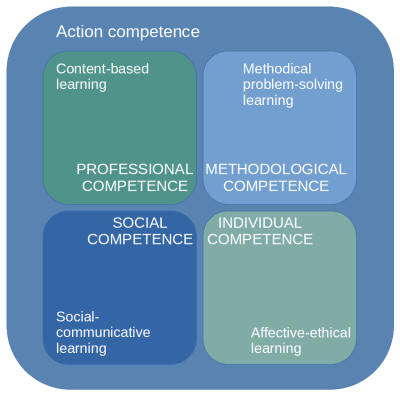Christian Stoll 2021
Basics of competence orientation
What is competence?
There are various definitions of competencies. These usually have a common core: competencies comprise all available physical and mental abilities and skills of a person to solve problems and the associated readiness to use this successfully and responsibly in different situations (Abels, 2011, p.20).
The concept of competence relates learning success to a multidimensional (holistic) development of a person. It is different, for example, with the concept of qualification, which refers to the usability and applicability of the learning success (Raithel et al., 2007, p.39).
Historical background
 Abb. 1: Johann Heinrich Pestalozzi
Abb. 1: Johann Heinrich Pestalozzi
Many (media-)didactic approaches to design learning processes in an appropriate and target group-oriented way go back to Johann Heinrich Pestalozzi (see Abbildung 1). The most important didactic approaches here are that education and educational institutions can only contribute to the development of a learner up to a certain point. Learners must be enabled to develop in a self-determined and independent way. According to Pestalozzi, the learning and development process of a person does not end after school or university. People should learn and develop throughout their lives. The most important contribution to one's development is the ability to examine and question oneself, i.e. to reflect (Raithel et al., 2007, p.112f.).
Another didactic approach that goes back to Pestalozzi is the idea of holistic experience-based learning. Pestalozzi was less concerned with the pure transmission of knowledge and more with the transmission of ideas and skills. Learners should make their own experiences and build their knowledge, skills, and abilities on them. Pestalozzi's well-known triad also refers to this: the „forming of head, heart and hand“ is one of Pestalozzi's essential didactical/methodical principles on which different reform pedagogical, didactical approaches and theories are still based today (Herkner; Pahl, 2018, p.2).
Hidden behind the symbol of a head are the cognitive abilities of a person to perceive, recognize but also understand, think through, internalize and reproduce things (Franke, 2005, p.12-16).
The symbol of the hands stands for psychomotor skills and abilities. This includes performing certain sequences of actions to create products of action. This includes writing as well as the use of tools and equipment (Franke, 2005, p.17-19).
The heart stands for affective-ethical skills. Whereas the term skills does not do justice to this subject area. It is more about attitudes, values and the question of to what extent a person has been sensitized regarding certain topics and issues (Franke, 2005, p.19-22).
From Pestalozzi's triad, different taxonomic systems (theoretical models) were derived. These are primarily used for the formulation of learning goals and are purely output-oriented. The best-known learning goal taxonomy is by Bloom et al. (1956). However, this learning goal taxonomy refers only to cognitive skills and does not make any statements regarding the other skills and abilities a person should develop. Bloom and other authors from the 1960s and 1970s developed learning goal taxonomies for the other ability domains based on this approach (Franke, 2005, p.12-22).
Cognitive domain (Bloom et al., 1956):
- knowledge
- understanding
- applying
- analysis
- synthesis
- evaluation
Psychomotor domain (Simpson, 1966)
- perception
- putting into readiness
- execution under guidance
- mechanical execution
- automatic sequence of movements
Affektiver Bereich (Krathwohl et al., 1975)
- values
- developing value order
- being determined by values
Holistic experience-based teaching and learning in Pestalozzi's sense should not only refer to one of these areas but should try to consider all areas as far as possible. One concept that has been developed against this background is the concept of competencies.
Competency model for general, (pre-)vocational and higher education
Based on the holistic understanding of teaching-learning processes according to Pestalozzi, amongst others the taxonomic systems by Bloom et al., the following competence model was constructed:
- professional competence (content-based learning)
- methodological competence (methodical problem-solving learning)
- individual competence (affective-ethical learning)
- social competence (social-communicative learning)
See Franke (2005, p.34), Frey (2004, p.904-905) and Raithel et al. (2007, p.40).
The perceptual, cognitive, and psychomotor areas can be included in professional competence and methodological competence. The affective area is included in the individual competence. In addition, social competence considers the fact that teaching-learning processes are always communicative or social processes that must be learned. This aspect is a useful addition, which has not been considered in the theories and systems described so far.
Professional competence includes the willingness and ability to solve tasks and problems based on professional skills and abilities in a goal-oriented, appropriate and independent manner and to assess the result (KMK, 2018, p.15).
Methodological competence includes knowledge of different methods and the ability and willingness to use them in a targeted, planned manner to solve tasks and problems. This includes analysing work objects, structuring work processes and subsequently reflecting on the work processes (KMK, 2018, p.16).
Social competence includes the willingness and ability to live and shape social relationships, to grasp and understand affections and tensions, and to engage and communicate with others rationally and responsibly. It also includes the ability to solve tasks and problems in cooperation with others, critical faculties and the ability to give constructive feedback (KMK, 2018, p.15).
Self-competence/individual competence includes the willingness and ability to clarify, think through and assess development opportunities, requirements and constraints in family, work and public life as an individual personality, to develop one's own talents and to make and develop life plans. It also integrates the development of thoughtful values, the self-determined commitment to values and the ability to justify and reflect on them (KMK, 2018, p.15).
This competence model underlies the Qualifications Framework for German Higher Education Qualifications (KMK, 2017, p.4) and the German Qualifications Framework for Lifelong Learning (DQR, 2011).
In vocational education, these four areas of competence are the basis for vocational action competence (Franke, 2005, p.33-37). The KMK defines action competence as follows:
„Action competence is understood as the individual's readiness and ability to behave in professional, social, and private situations in an appropriately reasoned manner as well as in an individually and socially responsible manner (KMK, 2018, p.15).“
This definition of action competence is very similar to the definition of competencies in general. It is therefore an obvious idea to adapt the competence model accordingly and to understand professional, methodological, social, and personal competence as partial competences of action competence (see Abbildung 3). The competence model can be applied in this form to vocational, pre-vocational, general, and higher education.
In Pestalozzi's sense, a sustainable development of learners' action competence is given when learners have the opportunity to become active themselves, to make their own experiences, and to reflect on them afterwards. This is true for online courses as well as for face-to-face courses. One tool for planning competence-oriented courses is the learning target field. As a methodical/didactic substructure, the action and project orientations are suitable for this.

